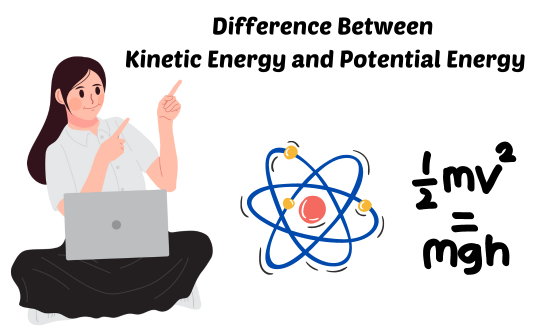
Introduction:
In this article, it will be explain Difference Between Kinetic Energy and Potential Energy. Thus, read this blog post through to the end if you want all the details of how kinetic and potential energy can be compared be each other.
Kinetic Energy:
The energy that an object has as a result of motion is known as kinetic energy. An object’s kinetic energy increases with there is an increase in its mass or velocity. The Kinetic Energy Calculator can also be used to determine kinetic energy.
Potential Energy:
In contrast, potential energy is like a secret energy source that is just waiting for the right time to appear. It is connected to the arrangement or position of an object about a force.
There are two common types of potential energy: gravitational potential energy (GPE) and elastic potential energy (EPE).
Gravitational Potential Energy (GPE):
This energy is due to the object’s height above the ground and the way it interacts with gravity. The gravitational potential energy of an object is directly proportional to its height.
Elastic Potential Energy (EPE):
Elastic potential energy is created by the deformation of elastic materials such as springs or rubber bands. These materials have stored energy that is released when they are released after which they change their shape and return to the initial form.
Kinetic Energy Formula
The following formula can be used to calculate Kinetic energy (KE)
KE = 0.5 * mass * velocity^2
Here, ‘mass’ is the mass of an object in kilograms while ‘velocity’ represents its speed in meters per second. The kinetic energy of an item can be calculated by multiplying half of its mass with velocity squared and it is usually measured in joules (J).
Potential Energy Formula
Since potential energy has two types, it can be calculated depending on the specific type.
Gravitational Potential Energy (GPE):
GPE = mass * gravitational acceleration * height
Elastic Potential Energy (EPE):
EPE = 0.5 * spring constant * (extension or compression)^2
Examples of Kinetic Energy & Potential Energy:
Example 1:
Imagine a roller coaster climbing an incline. As it is above ground level, its GPE is maximum at the top. The coaster accelerates downhill and converts its potential energy into kinetic energy (KE).
Example 2:
Imagine yourself with a rubber band that is stretched. It has EPE due to its deformation. When the rubber band is released, it returns to its original shape, producing kinetic energy that was stored and propelling the rubber band through space.
Difference Between Kinetic Energy and Potential Energy
| Differences | Kinetic Energy | Potential Energy |
|---|---|---|
| Origin | Arises from an object’s motion. | Arises from an object’s position or deformation relative to a force. |
| Formulas | KE = 0.5 * mass * velocity^2 | GPE = mass * gravitational acceleration * height EPE = 0.5 * spring constant * (extension or compression)^2 |
| Types | Only one type. | Two types. 1: Gravitational Potential Energy (GPE) 2: Elastic Potential Energy (EPE). |
| Direction of Energy | Always positive. | Gravitational Potential Energy (GPE) and Elastic Potential Energy (EPE) can be positive, while elastic compression potential energy can be negative. |
| Maximum Value | No upper limit. | Depends on height (GPE) or maximum deformation (EPE). |
| Energy Transfer | Energy transfer occurs during the object’s motion. | Energy transfer occurs when an object changes height (GPE) or deformation (EPE). |
Conclusion:
In conclusion, the energized duo kinetic energy and potential energy controls the amazing motion and transformations we observe every day all around us. The position or deformation of an object includes potential energy, while kinetic energy is obtained from the motion. The ability to understand these differences allows us to respect the wonderful topic of physics and how it influences our everyday lives.
FAQ’s
What is the difference between kinetic energy and potential energy?
Potential energy is the type of energy that an object has because of its position or location relative to other things while kinetic energy is the kind of energy a moving object has.
What are the differences in defining kinetic energy and potential energy?
The potential energy of an object is the amount of energy that this object contains based on its position or state, while kinetic energy refers to motion.
What type of energy does an object have if it is at rest?
An object that is at rest, does not move; it has potential energy but no kinetic energy.
What is the process through which energy changes from kinetic to potential?
As energy is transferred from one type to another, kinetic energy can be converted into potential energy and vice versa. For example, when a ball is thrown upwards, potential energy increases while the kinetic energy decreases. As it comes back up, kinetic energy increases and potential energy decreases.
What are energy conversions when referring to kinetic and potential energy?
As per the law of conservation of energy, energy can only be converted from one form to another and is neither created nor destroyed. In terms of kinetic and potential energy, one form of energy increases while the other decreases, however, the total amount remains constant.
